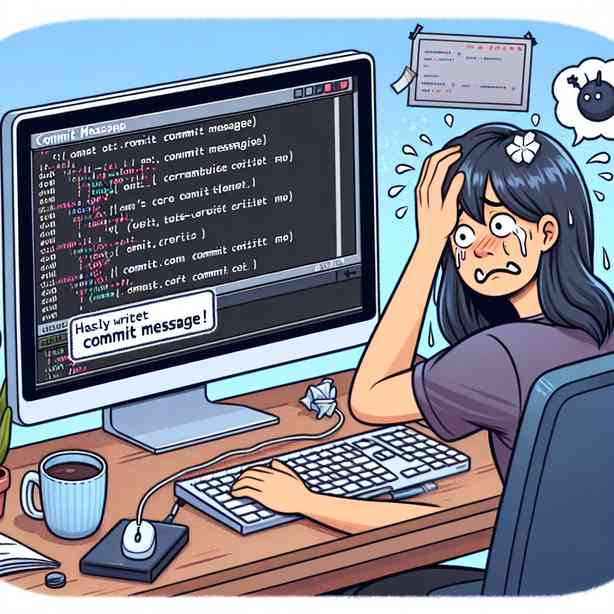
In the world of software development, commit messages play a crucial role in maintaining clear and organized project history. They provide context and insights into the changes made in the codebase, enabling team members to understand the rationale behind each modification. However, we’ve all experienced moments when we’ve written commit messages that we later regret. Such messages might be vague, unclear, or even unprofessional, leading to confusion among team members and hindering collaboration.
The importance of a well-crafted commit message cannot be overstated. When working in collaborative environments, a clear commit message can save time, foster better communication, and enhance overall productivity. Conversely, a poorly written message can lead to misunderstandings and a lack of direction. It’s not enough to simply summarize the changes made; rather, it’s essential to convey the reasoning behind them as well. This illustrates the significance of taking the time to think critically about how to articulate changes effectively.
Regretting the way we’ve documented changes is a common sentiment among developers. Have you ever sent a hasty commit message at the end of a long workday, only to realize later that it didn’t capture the essence of the change? Perhaps you used jargon that only you understood, or you failed to mention the impact of the change on the broader project. These scenarios can create friction within a team, as others may struggle to understand your intentions or, worse, misunderstand them entirely.
Writing a powerful commit message is an art that involves both brevity and clarity. It’s essential to recognize that each message serves not only as documentation for future reference but also as a form of communication to your teammates. Adopting a standard format can help maintain consistency and clarity across all commit messages in a project. One of the most common structures is the “imperative mood,” where the message starts with a verb, clearly indicating what the commit does. For example, “Fix bug in user authentication” clearly indicates an action, while also providing crucial context.
In contrast, vague commit messages like “Update files” or “Fix stuff” are nearly useless. They provide no insight into what was actually changed or why it mattered. This can lead to wasted time when others need to investigate the reasoning behind a commit, only to find they have no clue in which direction to look. To avoid regret, it’s crucial to practice writing thoughtful messages and to always ask ourselves: Would this message be clear to my future self? Would my teammates understand the purpose behind this change?
Regret can also stem from emotional responses to certain events within a project. For instance, we might write a commit message while feeling frustrated after dealing with a particularly tricky bug. In such moments, it’s easy to let emotions dictate the tone and wording of the message, leading to unintended consequences. A sarcastic remark or a frustrated tone can easily upset a teammate who reads it later. In the heat of the moment, it can be tempting to express our frustrations, but taking a step back to reflect might serve us better in the long run.
To cultivate a culture of constructive communication within a team, consider involving your coworkers in establishing standards for commit messages. Conduct a team discussion about what constitutes a good commit message. Collaboration in setting these standards not only ensures that everyone is on the same page but also promotes accountability among team members. Furthermore, revisiting and refining these practices periodically can contribute to continuous improvement and a shared understanding of effective communication within the team.
As we strive to improve our commit messaging practices, it’s also beneficial to embrace the use of tools that can aid in the process. Many version control systems and integrated development environments offer features that prompt users to provide meaningful commit messages. These prompts can serve as reminders to think carefully about what information should be included in the message. Additionally, conducting code reviews that focus on commit messages can foster a culture of awareness and constructive feedback, decreasing the likelihood of regrettable messages in the future.
Ultimately, the goal of conveying our intent through commit messages is to create a record that can guide not only our own understanding but also that of our fellow developers. The evolution of a project is documented within its version history, and each commit message serves as a milestone that helps us navigate that journey. Taking the time to reflect on the purpose of our changes, as well as ensuring that our messages are clear and professional, will work toward reducing those moments of regret.
In conclusion, the commit messages we write matter significantly in software development. When crafting these messages, it’s important to prioritize clarity, objectivity, and professionalism. Taking the time to reflect on and communicate well can alleviate confusion in the future and contribute to a healthier team dynamic. By sharing the responsibility of establishing standards for commit messages and engaging with tools that facilitate proper documentation, we can minimize the frequency of regrettable messages and enhance the overall efficiency of our projects. As we continue to learn and grow in our practices, let us remember the impact our words can have, not only on our own understanding but on the entire team as well.


